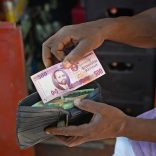Mozambique and Italy sign €30 million agreement to promote youth employment
Bank of Mozambique Holds Interest Rates Steady at 9.75%

In file Club of Mozambique / Bank of Mozambique.
The Bank of Mozambique has decided not to raise interest rates further, after three consecutive months in which the central bank’s key reference rates rose sharply.
A statement issued by the Bank’s Monetary Policy Committee on Friday, after its monthly meeting, announced that for the next month the Standing Lending Facility (the interest rate paid by the commercial banks to the central bank for money borrowed on the Interbank Money Market) will remain 9.75 per cent. This is the highest level the rate has been since 2012.
The Standing Deposit Facility (the rate paid by the central bank to the commercial banks on money they deposit with it) remains at 3.75 per cent, and the Compulsory Reserves Coefficient – the amount of money that the commercial banks must deposit with the Bank of Mozambique – also remains unchanged at 10.5 per cent.
The Committee’s statement said that the monetary measures taken in late 2015 had “staunched the volatility of the exchange rate” – and the Mozambican currency, the metical, has indeed shown signs of a recovery against the US dollar, and particularly against the South African rand.
Between January and November, the metical had depreciated by 73.2 per cent against the dollar, but there was a sharp reversal in the metical’s fortunes in December. That month saw the metical rise in value by 16.85 per cent on the Inter-Bank Exchange Market, ending the year at 44.95 meticais to the dollar. That brought the devaluation of the metical over the entire year of 2015 down to 42.25 per cent.
The picture was similar in the commercial banks, where the average exchange rate quoted on 31 December was 47.3 meticais to the dollar. That meant the rate had improved by 14.82 per cent in December. Over the year, the metical, as traded at the commercial banks, had depreciated by 39.6 per cent.
As for the South African currency, it fell back to well below three meticais to the rand. On 31 December, there were 2.88 meticais to the rand. The metical had gained in value by 23.4 per cent against the rand in December, and the annual depreciation against the rand was only 5.88 per cent.
The rand has been struggling against all other currencies, and its weakness has been widely attributed to South African President Jacob Zuma’s sacking of the well respected Finance Minister, Nhlanhla Nene, in early December. Whatever the cause, the weakness of the rand comes as a relief for Mozambican consumers, since so much of the country’s imported food comes from South Africa and is paid for in rands.
The Monetary Policy Committee noted that inflation in December, as measured by the Consumer Price Indices of the three largest cities (Maputo, Nampula and Beira) was 4.76 per cent, bringing annual inflation to 10.55 per cent, the highest since 2010. This was around five percentage points higher than the government’s target for inflation.
The Committee blamed the rise in inflation on such factors as the depreciation of the metical, the rise in prices determined by the government, such as for electricity and water, which had remained unchanged for five years, and speculation by shopkeepers during the festive season.
Provisional figures show that the country’s net international reserves rose to 1.997 billion US dollars (from 1.948 billion at the end of November), which was higher than expected. The main factor contributing to this was the disbursement of 77.6 million dollars of foreign aid in December.
The reserves are now sufficient to cover 3.84 months of imports of goods and non-factor services, when the operations of the foreign exchange mega-projects are excluded.
The Monetary Policy Committee also decided that the central bank will intervene in the inter-bank markets to ensure that, by the end of January, the monetary base does not exceed 70.211 billion meticais.
In December the monetary base rose by 7.862 billion meticais to reach 73.771. This was 6.3 per cent higher than the ceiling fixed for the month.
The Bank noted that the international prices of key Mozambican exports had fallen substantially in 2015 – thus the world market price of aluminium was down by 27.9 per cent, of natural gas by 19.5 per cent, and of thermal coal by 18 per cent.
On the other hand, Mozambique’s fuel bill has been cut by the continuing fall in the price of oil. Over the year, the price of the benchmark Brent crude fell by 34.7 per cent. On 31 December, Brent crude was quoted at 37.28 dollars a barrel, compared with 44.61 dollars in late November. The slide has continued in January, and on 14 January a barrel of Bret crude cost only 31.03 dollars.













Leave a Reply
Be the First to Comment!
You must be logged in to post a comment.
You must be logged in to post a comment.